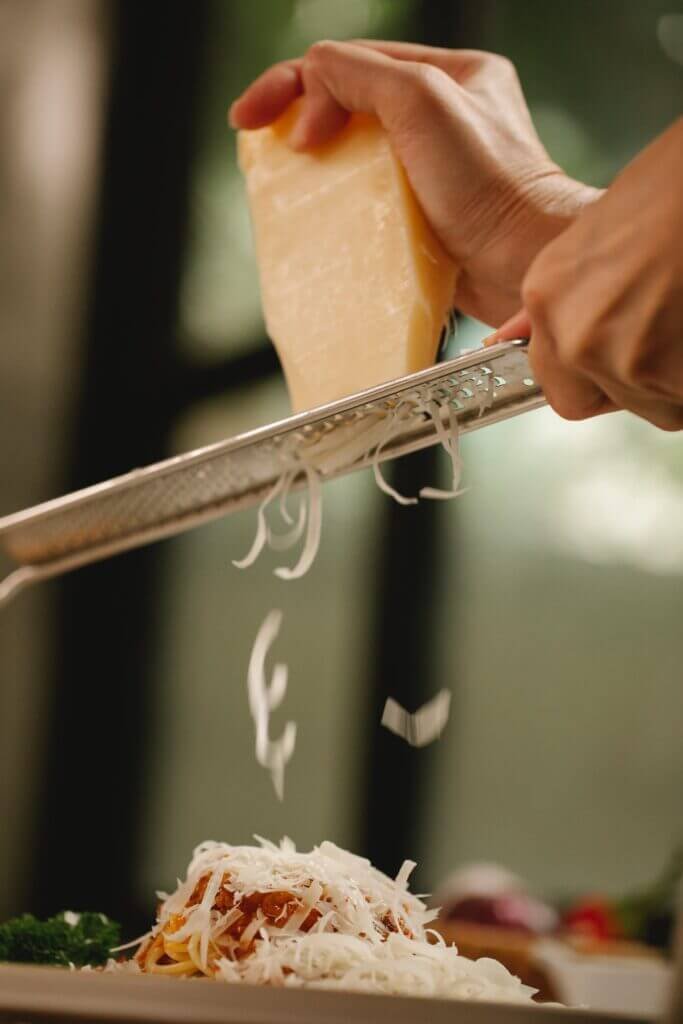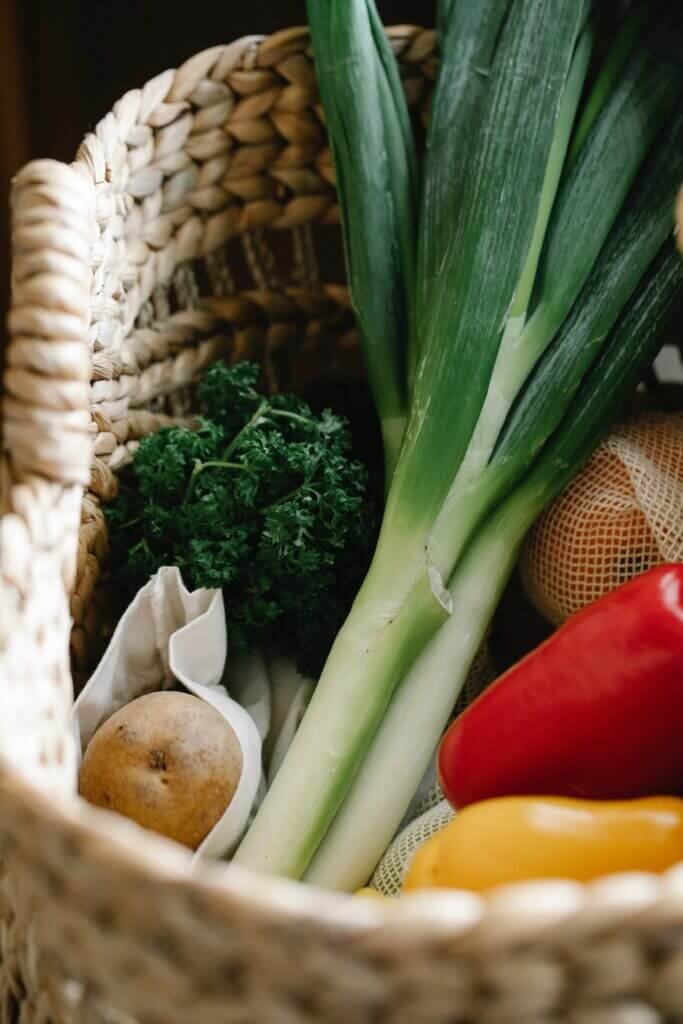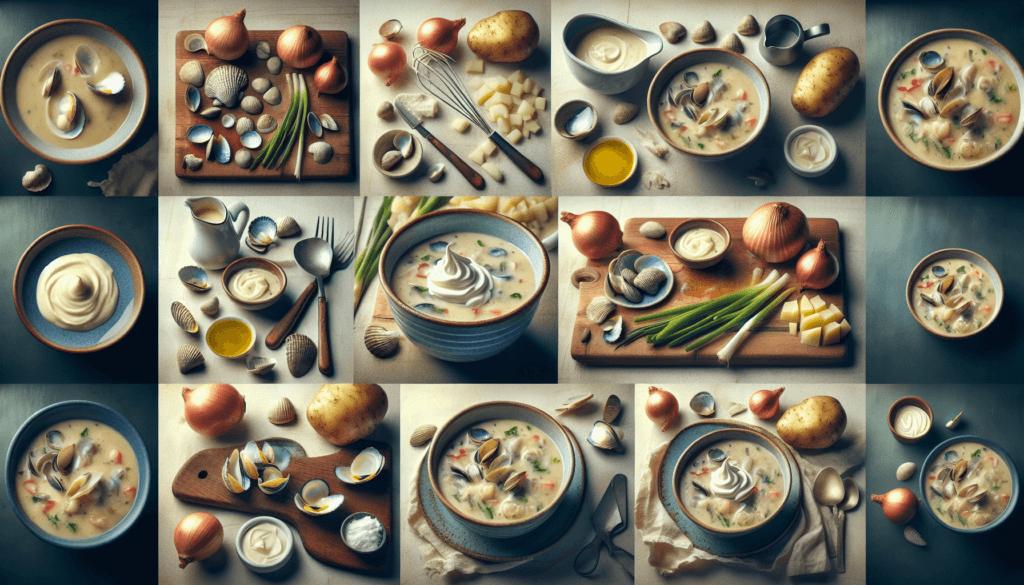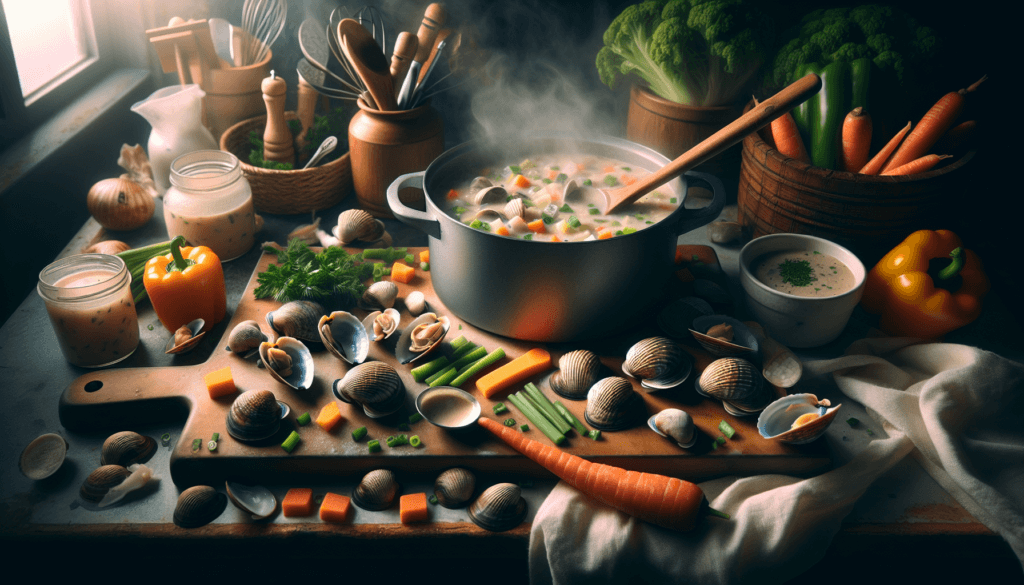Are you in the mood for a comforting and delicious meal? Look no further than homemade clam chowder! This article will guide you through the simple and easy steps to prepare a warm and satisfying bowl of this classic dish. With its creamy texture and flavorful combination of clams, potatoes, and spices, you’ll be able to enjoy a hearty and comforting meal right in the comfort of your own home. So, grab your apron and let’s get cooking!

Ingredients
To prepare a delicious bowl of homemade clam chowder, you will need the following ingredients:
Fresh Clams
Fresh clams are a crucial element in making clam chowder. Look for clams that are tightly closed and have a fresh, briny smell. Ensure that they are free from any cracks or chips.
Bacon
Bacon adds a smoky and savory flavor to the chowder. Use thick-cut bacon for the best results. Crispy bacon bits will be used as a topping, while the rendered fat will be used to sauté the aromatics.
Onion
Onions provide a subtle sweetness and depth of flavor to the chowder. Yellow or white onions work well in this recipe.
Celery
Celery adds a refreshing crunch and enhances the overall flavor profile of the chowder. Make sure to trim off any leaves and wash the celery stalks before using them.
Potatoes
Potatoes add substance and texture to the clam chowder. Choose starchy or all-purpose potatoes, such as Russets or Yukon Golds, as they will thicken the chowder naturally.
Garlic
Garlic adds a delightful aromatic element to the chowder and complements the flavors of the clams and bacon. Use fresh garlic cloves for the best flavor.
Flour
Flour is used to create a roux, which acts as a thickening agent for the chowder. All-purpose flour works well in this recipe.
Milk
Milk adds richness and creaminess to the chowder base. Use whole milk for a luscious and velvety texture.
Heavy Cream
Heavy cream takes the chowder to the next level of creaminess and indulgence. It adds a luxurious mouthfeel to the dish.
Bay Leaves
Bay leaves impart a subtle herbal flavor to the chowder. They add depth and complexity to the overall taste.
Thyme
Thyme is a fragrant herb that pairs beautifully with the flavors of clams and bacon. It adds a touch of earthiness and enhances the overall aroma.
Salt and Pepper
Salt and pepper are essential for seasoning the chowder. Season to taste, ensuring a balance between the flavors.
Parsley
Parsley is used as a garnish for the finished chowder. It adds a fresh and vibrant touch to the dish.
Preparing the Clams
Before incorporating the clams into the chowder, you need to clean, soak, cook, strain, and chop them. Here’s how you do it:
Cleaning and Soaking the Clams
Start by rinsing the clams under cold water to remove any dirt or impurities. Gently scrub the shells with a brush to ensure they are clean. Then, place the clams in a large bowl or basin of cold water and let them soak for about 20 minutes. This process helps to remove any excess sand or grit.
Cooking the Clams
Next, cook the clams by steaming them. In a large pot with a tight-fitting lid, add a few inches of water and bring it to a boil. Place the clams in the pot and cover it with the lid. Steam the clams for approximately 5-7 minutes or until the shells have opened. Discard any clams that do not open, as they may be unsafe to eat.
Straining and Chopping the Clams
Once the clams have cooked and cooled slightly, strain the clam juice using a fine-mesh sieve or cheesecloth. Reserve the clam juice for later use in the chowder. Remove the clams from their shells and give them a rough chop. Set aside the chopped clams until you’re ready to add them to the chowder.

Cooking the Bacon and Aromatics
The bacon and aromatics form the flavorful base of the clam chowder. Follow these steps to create a delicious foundation:
Cooking the Bacon
In a large pot or Dutch oven, cook the bacon over medium heat until it becomes crispy and golden brown. Once cooked, remove the bacon from the pot using a slotted spoon and set it aside on a plate lined with paper towels. Keep the rendered bacon fat in the pot, as it will be used to sauté the onions, celery, and garlic.
Sautéing the Onions and Celery
Add the chopped onions and celery to the pot with the rendered bacon fat. Sauté them over medium heat until they become translucent and slightly softened, about 5 minutes. Stir them occasionally to ensure even cooking and to prevent sticking.
Adding Garlic and Herbs
Once the onions and celery have softened, add the minced garlic, bay leaves, and thyme to the pot. Continue sautéing for an additional minute, or until the garlic becomes fragrant. The garlic and herbs will infuse the bacon fat, adding a delightful aroma to the chowder.
Making the Chowder Base
The chowder base provides the creamy and luxurious texture that clam chowder is known for. Here’s how to create a velvety base:
Creating a Roux
Sprinkle the flour over the cooked bacon, onions, celery, garlic, and herbs in the pot. Stir well to coat the ingredients evenly. Cook the mixture, stirring constantly, for approximately 2-3 minutes. This process cooks the raw flour taste out and helps to thicken the base.
Adding Milk and Heavy Cream
Gradually pour the milk and heavy cream into the pot, whisking constantly to incorporate the roux into the liquid. Continue whisking until the mixture becomes smooth and well combined. This will ensure a creamy and homogeneous chowder base.
Simmering the Chowder Base
Increase the heat to medium-high and bring the chowder base to a gentle simmer. Reduce the heat to low and let it simmer, uncovered, for about 10-15 minutes. Stir occasionally to prevent the mixture from scorching and to allow the flavors to meld together.
Seasoning with Salt and Pepper
Taste the chowder base and season it with salt and pepper according to your preference. Remember to season conservatively, as additional seasoning can be added later if needed. Stir well to ensure that the seasoning is evenly distributed throughout the chowder.

Preparing the Potatoes
Potatoes add a comforting and hearty element to the clam chowder. Follow these steps to prepare them:
Peeling and Dicing the Potatoes
Peel the potatoes and cut them into small, bite-sized cubes. Aim for uniformity in size to ensure even cooking. Place the diced potatoes in a colander and rinse them under cold water to remove any excess starch.
Boiling the Potatoes
In a separate pot, bring water to a boil and add a generous amount of salt. Carefully add the diced potatoes to the boiling water and cook them until they are tender but still hold their shape, approximately 10-15 minutes. Once cooked, drain the potatoes and set them aside until needed.
Combining the Ingredients
Now that you have prepared the clams, cooked the bacon and aromatics, created the chowder base, and prepped the potatoes, it’s time to bring everything together:
Adding the Chowder Base to the Pot with Potatoes
Carefully pour the prepared chowder base into the pot with the cooked diced potatoes. Stir gently to combine the ingredients, ensuring that the potatoes are fully coated with the creamy base.
Simmering the Chowder with Potatoes
Bring the chowder back to a gentle simmer over medium-low heat. Allow it to simmer for 10-15 minutes, stirring occasionally, to allow the flavors to meld and for the potatoes to absorb the creamy goodness.
Adding the Chopped Clams
Finally, add the chopped clams to the simmering chowder. Stir well to distribute the clams evenly throughout the chowder. Continue simmering for an additional 5 minutes to heat the clams and ensure they are cooked through.

Finishing Touches
To perfect your homemade clam chowder, pay attention to the final touches:
Adjusting the Consistency
If you prefer a thicker chowder, you can adjust the consistency at this stage. Simply simmer the chowder for a little longer to allow some of the liquid to evaporate and thicken, or use a potato masher to lightly mash some of the potatoes, releasing their starch and creating a thicker texture.
Seasoning with Additional Salt and Pepper
Taste the chowder once again and adjust the seasoning with additional salt and pepper if needed. Remember to add small increments of seasoning at a time, tasting after each addition, to avoid over-seasoning the dish.
Garnishing with Parsley
Before serving, sprinkle the freshly chopped parsley over the chowder. The vibrant green color adds a beautiful touch, enhancing the visual appeal of the dish. The parsley also adds a subtle hint of freshness to each bite.
Allowing the Chowder to Thicken
After adding the final touches, remove the chowder from the heat. Let it sit for a few minutes to allow the flavors to meld and the chowder to thicken slightly. This resting period will also help the individual components to harmonize, resulting in a more cohesive and flavorful dish.
Serving and Storing
Now that your warm and satisfying bowl of homemade clam chowder is ready, here’s how to serve and store it:
Serving the Clam Chowder
Ladle the clam chowder into bowls, ensuring that each serving has an equal amount of clams, potatoes, and creamy base. Serve the clam chowder while it is hot, as it is most enjoyable when it is warm and comforting. Pair it with crusty bread or oyster crackers for a delightful spin on the classic pairing.
Storing Leftovers
If you have any leftovers, allow the clam chowder to cool completely before transferring it to an airtight container. Store it in the refrigerator for up to 2-3 days. When reheating the chowder, do so gently over low heat to avoid boiling, as excessive heat can cause the chowder to separate or become grainy in texture.

Tips for Success
To ensure your clam chowder turns out perfectly every time, consider these helpful tips:
Using Fresh Clams
The quality of the clams directly impacts the flavor of the chowder. Always opt for fresh clams that are alive and tightly closed. Avoid clams with cracked or damaged shells, as they may be spoiled or unsafe to eat. The fresher the clams, the better the taste of your clam chowder will be.
Keeping the Clam Juice
The clam juice is a precious liquid that contains the essence of the clams. Be sure to strain and preserve the clam juice after steaming the clams. It can be added to the chowder during the cooking process to intensify the clam flavor and provide additional depth to the dish.
Adding Flavor with Bacon
Bacon adds a depth of smoky and savory flavor to the chowder. When cooking the bacon, be sure to render it until it’s crispy and golden brown. The rendered bacon fat will infuse the aromatics and chowder base, elevating the overall taste of the dish.
Properly Seasoning the Chowder
Seasoning is key to a well-balanced clam chowder. Start with a moderate amount of salt and pepper and gradually adjust to taste. Remember that the flavors will concentrate as the chowder cooks and reduces, so it’s important to season conservatively.
Allowing Flavors to Meld
Simmering the chowder allows the flavors to meld together, resulting in a more harmonious and flavorful dish. Be patient and give the chowder enough time to simmer, stirring occasionally to prevent sticking and scorching. The longer the chowder simmers, the more pronounced and delicious the flavors will become.
Reheating Without Boiling
When reheating leftover clam chowder, do so gently over low heat. Avoid boiling the chowder, as excessive heat can cause the ingredients to separate or the texture to become grainy. Slow and gentle reheating will help retain the creamy consistency and ensure the chowder remains as satisfying as when it was initially prepared.
Variations
If you want to explore different flavors or add variety to your clam chowder, consider these variations:
New England-Style Clam Chowder
To make a New England-style clam chowder, use a bacon and cream-based chowder with a creamy, white appearance. Omit the celery and use more onions for added sweetness. Additionally, add cubed potatoes to create a heartier texture and include a splash of Worcestershire sauce for a hint of tanginess.
Manhattan Clam Chowder
For a lighter and tomato-based version of clam chowder, try making Manhattan clam chowder. Substitute the creamy base with a tomato broth, and include diced tomatoes, carrots, and bell peppers for a vibrant and tangy twist. This variation offers a refreshing alternative to the traditional chowder.
Creamy Bacon and Corn Chowder
To add a touch of sweetness and texture to your clam chowder, incorporate corn kernels and create a creamy bacon and corn chowder. Add fresh or frozen corn to the chowder ingredients, and follow the same cooking and seasoning process. The corn adds a delightful burst of flavor and complements the clams and bacon perfectly.
Seafood Medley Chowder
For a seafood lover’s delight, consider making a seafood medley chowder. In addition to clams, add other seafood such as shrimp, crab, or lobster to the chowder base. This variation offers a decadent mix of flavors and textures and is sure to impress your guests.
By following these steps and tips, you’ll be able to prepare a warm and satisfying bowl of homemade clam chowder that will delight your taste buds and warm your soul. Enjoy the comforting flavors and savor the rich and creamy goodness that homemade clam chowder has to offer!


